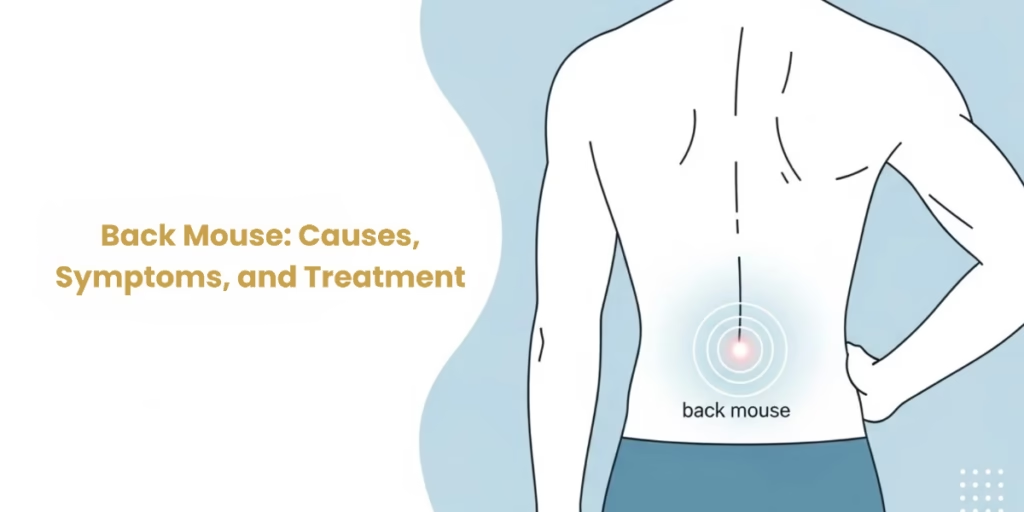The term back mouse may sound unusual, but it is a real health condition that many people experience. Despite its name, it has nothing to do with rodents. Instead, a back mouse refers to a small, tender lump that forms in the lower back or hip area. For some people, it causes little trouble, but for others, it can be painful and limit daily activities.
If you’ve noticed a lump in your lower back and are worried, you’re not alone. This guide will walk you through what a back mouse is, why it happens, how to recognize it, and the options available for relief. Our goal is to explain this condition in simple, inclusive, and easy-to-understand language.
What is a Back Mouse?
A back mouse—sometimes called an episacral lipoma or myofascial nodule—is a small lump that appears when fat tissue pushes through the fascia, which is a layer of connective tissue under the skin. This usually happens in the lower back or near the hips.
While the lump is benign (non-cancerous), it can still be uncomfortable. Many people confuse it with other conditions such as cysts, lipomas, or even nerve-related pain like sciatica. Because of these similarities, a proper diagnosis is important.
What Causes a Back Mouse?
Several factors may lead to the development of a back mouse. These include:
- Connective tissue weakness: Fascia can weaken due to age, stress, or genetic factors, allowing fat tissue to slip through.
- Physical strain or injury: Repeated bending, heavy lifting, or sudden injuries may damage the fascia.
- Changes in body weight: Fluctuations in weight can place more pressure on the tissue.
- Hormonal influences: Shifts in hormones, especially in women, may affect fat distribution.
- Family history: Some people are more likely to develop connective tissue issues.
It’s important to note that anyone can develop a back mouse—there’s no single “type” of person at risk.
Common Symptoms
Not all back mice are painful, but when symptoms do occur, they may include:
- A small, noticeable lump in the lower back or hip region
- Tenderness or pain when pressing the area
- Discomfort after sitting or bending for long periods
- Pain spreading to the hips or thighs (sometimes mistaken for sciatica)
- Increased sensitivity after physical activity
If the lump is not painful, many people never realize they have a back mouse.
How Doctors Diagnose Back Mouse
Healthcare providers usually diagnose back mouse through:
- Physical exam: A doctor checks the lump by touch, noting its size and tenderness.
- Medical history: Information about your activities, past injuries, and lifestyle is considered.
- Imaging tests: Ultrasound or MRI may be used to confirm the diagnosis and rule out other causes such as cysts or tumors.
👉 If you discover a lump in your back, don’t panic. Most lumps are harmless, but getting a professional evaluation is always the safest choice.
Treatment Options
Treatment depends on how much discomfort the back mouse is causing. Some people need little more than reassurance, while others benefit from targeted care.
1. Self-Care and Lifestyle Adjustments
- Rest when needed but stay gently active.
- Apply heat or cold packs to ease soreness.
- Over-the-counter pain relief may help in flare-ups.
- Massage or gentle stretching can reduce tension around the lump.
2. Medical Treatments
- Local anesthetic injections often provide quick relief.
- Steroid injections reduce inflammation and swelling.
- Needling techniques or acupuncture may break down tissue tightness.
- Surgical removal is rare and only recommended for persistent, severe cases.
3. Supportive Therapies
- Physical therapy strengthens muscles and improves posture.
- Chiropractic adjustments may ease related back strain.
- Yoga or pilates support flexibility and core stability.
Home Remedies That Can Help
For mild cases, small daily changes can make a difference:
- Gentle movements: Walking, swimming, and stretching are safe.
- Healthy posture: Sit with lumbar support and avoid slouching.
- Balanced weight management: Maintaining a steady body weight reduces strain.
- Supportive sleep setup: Use a mattress and pillows that align your spine.
Can a Back Mouse Be Prevented?
Not every back mouse can be prevented, but you can lower your chances by:
- Building core strength to support your lower back
- Avoiding repetitive strain from lifting or twisting
- Choosing ergonomic chairs and supportive mattresses
- Staying active with low-impact exercise
- Practicing good posture throughout the day
These habits not only help with back mouse but also support overall back health.
How Back Mouse Differs From Other Conditions
Back mouse is often mistaken for:
- Lipomas – soft, fatty lumps that are usually painless
- Cysts – fluid-filled lumps that can become inflamed
- Sciatica – nerve pain that radiates down the leg
The key difference is that a back mouse is tender when pressed and linked to connective tissue rather than nerves or fluid buildup.
Frequently Asked Questions
1. Is a back mouse serious?
No. It is benign, but it can cause pain and discomfort if untreated.
2. Can it go away on its own?
Sometimes mild cases improve with lifestyle changes, but persistent pain often requires treatment.
3. Will exercise make it worse?
High-impact workouts can increase discomfort. Low-impact activities like walking, swimming, and yoga are generally better.
4. How is a back mouse treated by doctors?
Doctors may recommend injections, physical therapy, or in rare cases, minor surgery.
5. Should I be worried if I feel a lump in my back?
Most lumps are harmless, but it’s always best to see a healthcare provider to rule out other conditions.
When to See a Doctor
Consider seeking medical advice if you:
- Notice the lump getting bigger
- Experience severe or persistent pain
- Have numbness or tingling in your legs
- Do not find relief from home remedies
Final Thoughts
A back mouse may have a funny name, but it is a real condition that can impact daily life. Thankfully, it is not dangerous and is treatable with the right approach. From simple self-care routines to medical treatments, there are many ways to find relief.
If you ever find yourself worried about a lump in your back, remember: you’re not alone, and help is available. The key is to get a proper diagnosis and choose a treatment plan that works best for your body and lifestyle.
Read Also : Best Medication for Back Pain: Top 10 Treatments







